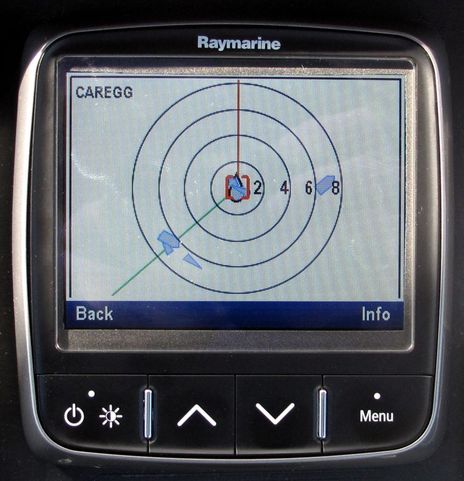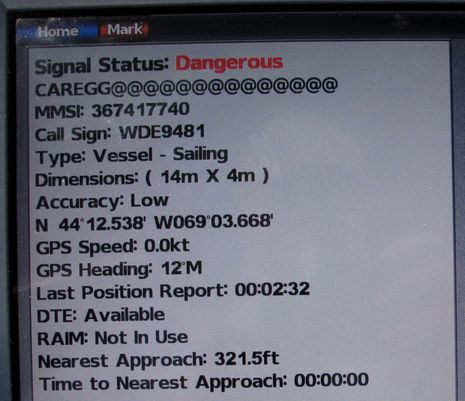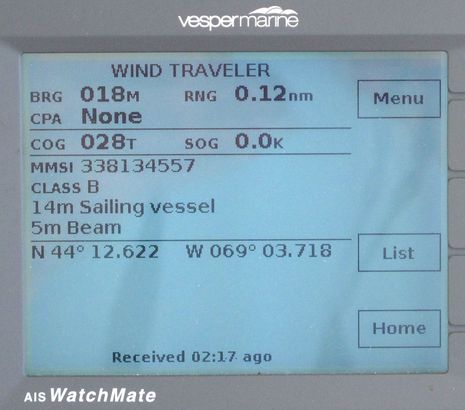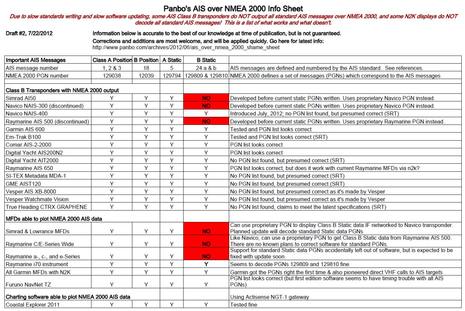AIS over NMEA 2000, the shame sheet!

It was a beautiful weekend in Maine, and we deserved one, but sorry to report that there were sighs and curses of surprise and disappointment emanating from the good vessel Gizmo. I may be late with this year's (way over the top ;-) electronics installations, but that's what Gizmo is about, and I was looking forward to seeing how a new-to-me Em-Trak B100 Class B AIS transponder would work with a wide variety of displays that could use its NMEA 2000 output. As discussed here last June, the B100 is a compact, feature-rich, affordable transponder, especially compared to some others with N2K output. And while there was a glitch in early implementations of AIS over NMEA 2000, I had presumed that the major manufacturers involved had worked that out. Damn it, I was wrong...
Some things went fine, and let me emphasize that I detected nothing wrong with the Em-Trak B100 whatsoever. In fact, it was really easy to program because it can power up (and even receive AIS) with just its USB cable, and Windows 7 even found the drivers for it without a fuss (others come on an included CD). Apparently the B100 can also be programmed via SD card -- a nice thing for dealer/installers in the U.S. since civilians here are not allowed to enter their MMSI number (though they can use the included ProAIS2 software to change other fields, diagnose performance, and more). An SD card can also collect voyage info, your own and targets, and I've already figured out an easy way to display it (see below).
I also experienced some NMEA 2000 plug and play goodness, as with that nifty Raymarine i70 in the top photo. (I got a taste of the i70's unique and useful AIS display last fall, but didn't realize it can even scale targets.) As soon as it was on the same network with the B100, it started showing AIS targets and after a while it had all of each target's static data available under that Info soft key, which elicited a whoop of surprise because that was not the case with the Raymarine e7...

Actually the first MFD I networked to the B100 was that Simrad NSS above left, and I had low expectations because of recent comments on the original Em-Trak entry. Navico, after all, had been first with a Class B transponder that output NMEA 2000 and they'd had to write a proprietary PGN for the Class B static data because NMEA hadn't finished it yet. Plus they programmed their MFDs to understand that special PGN. Fine and dandy, but that was years ago, and yet it seems that Navico has not yet updated its transponders or its MFDs to work with the standard messages (as I had presumed). It doesn't matter how long you leave that NSS on, it only sees Class B targets as an MMSI number with position, course, speed, etc...never the vessel's name, call sign, type, and dimensions.
So I thought I'd motivate Navico to fix this by setting up the Raymarine e7 up on the same network and photograph its complete listing of the same AIS targets. But the e7 failed to get Class B static data over N2K too!...

Could there be something amiss with the output of the B100? Nah. Above is a screenshot of the same data stream as seen in Actisense's NMEA Reader on Gizmo's Mac Mini (via the same company's gateway, which makes it available to many charting programs on the PC). It sure looks like the B100 is putting out PGNs 129809 and 129810 -- also known as the Class B "CS" Static Data Reports, both A and B -- that make sense in the official Standard that Actisense used to parse and label the fields...

And the good old Garmin 7212 -- which along with a Garmin AIS 600, has been doing AIS over NMEA 2000 fine for a long time on Gizmo -- didn't have have any trouble with the B100 output either. Well, I will take this opportunity to chide Garmin again about its AIS alarming. A vessel can be 321.5 feet away from mine and not be Dangerous, for days at time in fact, and thus it's annoying to get alarmed every time I turn the Garmin on...

Actually, all the MFDs I've used with AIS could use improved alarming, I think, and Vesper Marine has been providing examples of how to do it right for years. They have also demonstrated how to present target data well (and note that the WatchMate stripped those "@" space symbols out of the Class B vessel "Caregg" name as did the Ray i70 above). Vesper is about to enter the world of AIS over NMEA 2000, and WiFi, and I'll bet they do a great job of it...

Another AIS plotter to watch is Coastal Explorer, which is now ranking targets in the "Passing" categories seen above. I just noticed this feature today, but I think I like it a lot. The Class B sailing yacht Isobel was not going to collide with me in Camden Harbor, but it was neat the way it jumped to the top of the list after it tacked. Another neat thing about the screen shot is that though CE works great with N2K AIS, the data above is actually a NMEA 0183 log collected by the Em-Trak B100 on an SD card. I just had to rename the file extension "nmea" and the free utility GPSGate will play it to virtual com ports, TCP/IP, etc where most any charting/AIS program should be able to read it. I'm not sure if there are file size limits -- three hours of this sort of AIS density equals a 3 mb file -- but I think I have a voyage recorder now!
And, incidentally, I think the AIS range I'm seeing from Camden Harbor is as good as, or better than, any other AIS receiver I've tried, and the transmission range looks good too (I can see Gizmo via my shore listening station a mile away, which isn't true of all Class B's because there's a lot of earth and trees in between). Plus the Em-Trak B100 -- $550 at West Marine -- is not the only economical N2K Class B transponder these days. How about the Si-Tex Metadata, which looks like a close cousin to the B100 except that it has an internal GPS antenna to make installation easier.
But here's the thing: I'm pretty sure that none of these AIS transponders will work to complete satisfaction over NMEA 2000 with the current MFDs of two major manufacturers, and that just doesn't seem right. Unless I somehow messed up my testing -- which in fact is largely confirmed by the PGN lists being collected by the great Panbot "Norse" -- you will not see the names and details of Class B vessels on current Navico and Raymarine MFDs. I know there's a lot of history to this -- heck, the late development of AIS message 24 caused Class B users to think ships didn't see them before the lateness of the PGN equivalent caused this little mess -- but I think it's easily fixed in this case. I'm pretty sure that an MFD can be programmed to recognize both the standard PGNs and the proprietary one a company may have already written (though I'd like confirmation of that).
At any rate, I'm not quite ready to publish the PDF seen below -- I want the manufacturer responses first, and there are more products to add -- but it will hopefully become a real world list of what does and does not work when it comes to networking AIS transponders and AIS plotting devices over NMEA 2000. When it works right, AIS over N2K is great...easy to install, easily distributed around a boat, and hopefully future proofed...but it doesn't always work right.
 PS 7/22: I finally have the whole Panbo AIS over NMEA 2000 Info Sheet.pdf ready for download, and I'm glad I waited as there have been several positive developements in the meantime. I've already seen full Class B data over N2K on a Simrad NSS, for instance, though the actual software update is still not released. I trust that Raymarine is headed the same way, and both companies now have transponders that use all the standard PGNs. In fact, I've edited "shame" out of the sheet. Nonetheless it can help boaters with older N2K transponders and displays to understand possible limitations. Plus the document now includes a brief history of the AIS standard that I wrote and some excellent reference material collected by Panbo reader Norris. Thanks, Norris!
PS 7/22: I finally have the whole Panbo AIS over NMEA 2000 Info Sheet.pdf ready for download, and I'm glad I waited as there have been several positive developements in the meantime. I've already seen full Class B data over N2K on a Simrad NSS, for instance, though the actual software update is still not released. I trust that Raymarine is headed the same way, and both companies now have transponders that use all the standard PGNs. In fact, I've edited "shame" out of the sheet. Nonetheless it can help boaters with older N2K transponders and displays to understand possible limitations. Plus the document now includes a brief history of the AIS standard that I wrote and some excellent reference material collected by Panbo reader Norris. Thanks, Norris!

 Share
Share
Sometimes it is unbelievable how slow NMEA 2000 development is...
I heard that Navico is going to release a replacement for the NAIS-300, I guess that once that is released they will fix this silly Class B omission in the MFDs.